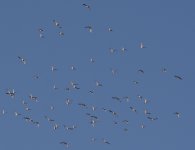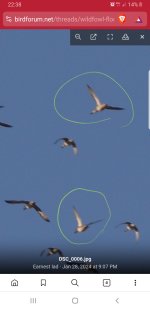Earnest lad
Well-known member
During a recent trip to the above venue, I managed to take a photo of an unidentified overflying flock of birds. Upon arrival back home I was able to look at the photo, with a view to ascertaining if possible the species of bird in the photo.
However, my effort to clinch the species has been in vain. Therefore I request the help here please in case someone can tell what the birds are.
Regrettably, not a lot of detail seems to be on view in the image, in spite of the high number of birds.
As far as I can tell, these birds seem to be some kind of wildfowl. I think I can see a duck-like bill on one or two of the birds. Still I could be mistaken.
Thanks in advance.
However, my effort to clinch the species has been in vain. Therefore I request the help here please in case someone can tell what the birds are.
Regrettably, not a lot of detail seems to be on view in the image, in spite of the high number of birds.
As far as I can tell, these birds seem to be some kind of wildfowl. I think I can see a duck-like bill on one or two of the birds. Still I could be mistaken.
Thanks in advance.








